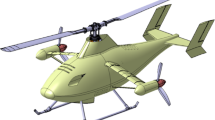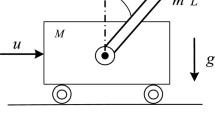Abstract
Tower cranes are well-known underactuated systems, where the design of controllers for them with time-varying rope length was weak in the past because of their complex dynamic characteristic. The payload oscillation will become worse when the jib slew angle, the trolley position and the rope length are changed simultaneously. The proposed method is designed based on robust adaptive sliding mode control via tracking nonzero initial reference trajectories, in which frictions and lumped disturbances in the crane system are eliminated, and unknown payload mass is effectively estimated online. Lyapunov technique is combined with LaSalle’s invariance theorem to design controller and analyze stability. Various and strict simulations are applied, which validate the effectiveness and extreme robustness of the proposed method.







Similar content being viewed by others
Data Availability Statement
The datasets generated and analyzed during the current study are available from the corresponding author on reasonable request.
References
Liu, W., Chen, S., Huang, H.: Double closed-loop integral terminal sliding mode for a class of underactuated systems based on sliding mode observer. Int. J. Control Autom. Syst. 18, 339–350 (2020)
Seifried, R.: Dynamics of underactuated multibody systems: Modeling, control and optimal design. Springer International Publishing, Cham (2014)
Yabuno, H., Kobayashi, S.: Motion control of a flexible underactuated manipulator using resonance in a flexible active arm. Int. J. Mech. Sci. 174, (2020)
Yin, H., Chen, Y., Huang, J.H.: L\({\ddot{{\rm u}}}\), Tackling mismatched uncertainty in robust constraint-following control of underactuated systems. Inf. Sci. 520, 337–352 (2020)
Montoya, O.D., Gil-Gonzalez, W.: Nonlinear analysis and control of a reaction wheel pendulum: Lyapunov-based approach. Eng. Sci. Technol. Int. J. 23, 21–29 (2020)
Zhang, S., He, X., Zhu, H., Chen, Q., Feng, Y.: Partially saturated coupled-dissipation control for underactuated overhead cranes. Mech. Syst. Signal Process. 136, (2020)
Chereji, E., Radac, M., Szedlak-Stinean, A.: Sliding mode control algorithms for anti-lock braking systems with performance comparisons. Algorithms 14, 2 (2021)
Liu, J., Sun, M., Chen, Z., Sun, Q.: Super-twisting sliding mode control for aircraft at high angle of attack based on finite-time extended state observer. Nonlinear Dyn. 99, 2785–2799 (2020)
Wang, S., Tao, L., Chen, Q., Na, J., Ren, X.: USDE-Based sliding mode control for servo mechanisms with unknown system dynamics. IEEE/ASME Trans. Mechatron. 25, 1056–1066 (2020)
Pappalardo, C.M., Guida, D.: On the dynamics and control of underactuated nonholonomic mechanical systems and applications to mobile robots. Arch. Appl. Mech. 89, 669–698 (2019)
Ding, F., Huang, J., Wang, Y., Zhang, J., He, S.: Sliding mode control with an extended disturbance observer for a class of underactuated system in cascaded form. Nonlinear Dyn. 90, 2571–2582 (2017)
Ashrafiuon, H., Erwin, R.S.: Sliding mode control of underactuated multibody systems and its application to shape change control. Int. J. Control 81, 1849–1858 (2008)
Maghsoudi, M.J., Mohamed, Z., Husain, A.R., Tokhi, M.O.: An optimal performance control scheme for a 3D crane. Mech. Syst. Signal Process. 66–67, 756–768 (2016)
Tuan, L.A.: Fractional-order fast terminal back-stepping sliding mode control of crawler cranes. Mech. Mach. Theory 137, 297–314 (2019)
Lu, B., Fang, Y., Sun, N.: Sliding mode control for underactuated overhead cranes suffering from both matched and unmatched disturbances. Mechatronics 47, 116–125 (2017)
Chen, H., Fang, Y., Sun, N.: An adaptive tracking control method with swing suppression for 4-DOF tower crane systems. Mech. Syst. Signal Process. 123, 426–442 (2019)
Gao, J., Wang, L., Gao, R., Huang, J.: Adaptive control of uncertain underactuated cranes with a non-recursive control scheme. J. Franklin Inst. 356, 11305–11317 (2019)
Zhang, M., Zhang, Y., Ouyang, H., Ma, C., Cheng, X.: Adaptive integral sliding mode control with payload sway reduction for 4-DOF tower crane systems. Nonlinear Dyn. 99, 2727–2741 (2020)
Le, A.T., Lee, S.: 3D cooperative control of tower cranes using robust adaptive techniques. J. Franklin Inst. 354, 8333–8357 (2017)
Ouyang, H., Wang, J., Zhang, G., Mei, L., Deng, X.: Novel adaptive hierarchical sliding mode control for trajectory tracking and load sway rejection in double-pendulum overhead cranes. IEEE Access 7, 10353–10361 (2019)
Zhang, S., He, X., Chen, Q.: Energy coupled-dissipation control for 3-dimensional overhead cranes. Nonlinear Dyn. 99, 2097–2107 (2020)
Sun, N., Yang, T., Fang, Y., Lu, B., Qian, Y.: Nonlinear motion control of underactuated three-dimensional boom cranes with hardware experiments. IEEE Trans. Ind. Inform. 14, 887–897 (2018)
Ho, T.D., Terashima, K.: Robust control designs of payloads skew rotation in a boom crane system. IEEE Trans. Control Syst. Technol. 27, 1608–1621 (2019)
Wu, X., Xu, K., He, X.: Disturbance-observer-based nonlinear control for overhead cranes subject to uncertain disturbances. Mech. Syst. Signal Process. 139, (2020)
Golovin, I., Palis, S.: Robust control for active damping of elastic gantry crane vibrations. Mech. Syst. Signal Process. 121, 264–278 (2019)
Kolar, B., Rams, H., Schlacher, K.: Time-optimal flatness based control of a gantry crane. Control Eng. Pract. 60, 18–27 (2017)
Hamdy, M., Shalaby, R., Sallam, M.: Experimental verification of a hybrid control scheme with chaotic whale optimization algorithm for nonlinear gantry crane: a comparative study. ISA Trans. 98, 418–433 (2020)
Rincon, L., Kubota, Y., Venture, G., Tagawa, Y.: Inverse dynamic control via simulation of feedback control by artificial neural networks for a crane system. Control Eng. Pract. 94, (2020)
Tuan, L.A., Cuong, H.M., Trieu, P.V., Nho, L.C., Thuan, V.D., Anh, L.V.: Adaptive neural network sliding mode control of shipboard container cranes considering actuator backlash. Mech. Syst. Signal Process. 112, 233–250 (2018)
Ramli, L., Mohamed, Z., Efe, M., Lazim, I.M., Jaafar, H.I.: Efficient swing control of an overhead crane with simultaneous payload hoisting and external disturbances. Mechanical Systems and Signal Processing 135, (2020)
Li, X., Peng, X., Geng, Z.: Anti-swing control for 2-D under-actuated cranes with load hoisting/lowering: a coupling-based approach. ISA Trans. 95, 372–378 (2019)
Zhang, Z., Wu, Y., Wu, Y., Huang, J., Huang, J.: Differential-flatness-based finite-time anti-swing control of underactuated crane systems. Nonlinear Dyn. 87, 1749–1761 (2017)
Sun, N., Fang, Y., Chen, H., He, B.: Adaptive nonlinear crane control with load hoisting/lowering and unknown parameters: design and experiments. IEEE/ASME Trans. Mechatron. 20, 2107–2119 (2015)
Lu, B., Fang, Y., Sun, N.: Enhanced-coupling adaptive control for double-pendulum overhead cranes with payload hoisting and lowering. Automatica 101, 241–251 (2019)
Maghsoudi, M.J., Ramli, L., Sudin, S., Mohamed, Z., Husain, A.R., Wahid, H.: Improved unity magnitude input shaping scheme for sway control of an underactuated 3D overhead crane with hoisting. Mech. Syst. Signal Process. 123, 466–482 (2019)
Peng, J., Xu, W., Yang, T., Hu, Z., Liang, B.: Dynamic modeling and trajectory tracking control method of segmented linkage cable-driven hyper-redundant robot. Nonlinear Dyn. 101, 233–253 (2020)
Yang, T., Sun, N., Chen, H., Fang, Y.: Observer-Based nonlinear control for tower cranes suffering from uncertain friction and actuator constraints with experimental verification. IEEE Trans. Ind. Electron. 68, 6192–6204 (2021)
Zhang, M., Zhang, Y., Ji, B., Ma, C., Cheng, X.: Adaptive sway reduction for tower crane systems with varying cable lengths. Autom. Constr. 119, (2020)
Sun, N., Wu, Y., Chen, H., Fang, Y.: Antiswing cargo transportation of underactuated tower crane systems by a nonlinear controller embedded with an integral term. IEEE Trans. Autom. Sci. Eng. 16, 1387–1398 (2019)
Zhou, X., Li, X.: A finite-time robust adaptive sliding mode control for electro-optical targeting system with friction compensation. IEEE Access 7, 166318–166328 (2019)
Sun, N., Fang, Y., Zhang, Y., Ma, B.: A novel kinematic coupling-based trajectory planning method for overhead cranes. IEEE/ASME Trans. Mechatron. 17, 166–173 (2012)
Sun, N., Zhang, X., Fang, Y., Yuan, Y.: Transportation task-oriented trajectory planning for underactuated overhead cranes using geometric analysis. IET Control Theory Appl. 6, 1410–1423 (2012)
Hoang, N.Q., Lee, S., Kim, H., Moon, S.: Trajectory planning for overhead crane by trolley acceleration shaping. J. Mech. Sci. Technol. 28, 2879–2888 (2014)
Han, J.: Active Disturbance Rejection Control Technique-the Technique for Estimating and Compensating the Uncertainties. National Defense Industry Press, Beijing (2008)
Khalil, H.K.: Nonlinear Systems, 3rd edn. Prentice-Hall, Englewood Cliffs, NJ, USA (2002)
Acknowledgements
This work is supported in part by the National Natural Science Foundation of China under Grants 51707092 and 61703202 and in part by the Postgraduate Research and Practice Innovation Program of Jiangsu Province under Grant SJCX21_0480.
Author information
Authors and Affiliations
Corresponding author
Ethics declarations
Conflict of interest
The authors declare that there is no conflict of interests regarding the publication of this article.
Additional information
Publisher's Note
Springer Nature remains neutral with regard to jurisdictional claims in published maps and institutional affiliations.
Appendices
Appendix A
The detailed expressions of (8) are as follows:
Appendix B
The detailed terms in (13) and (14) are shown as follows:
Rights and permissions
About this article
Cite this article
Tian, Z., Yu, L., Ouyang, H. et al. Sway and disturbance rejection control for varying rope tower cranes suffering from friction and unknown payload mass. Nonlinear Dyn 105, 3149–3165 (2021). https://doi.org/10.1007/s11071-021-06793-6
Received:
Accepted:
Published:
Issue Date:
DOI: https://doi.org/10.1007/s11071-021-06793-6




